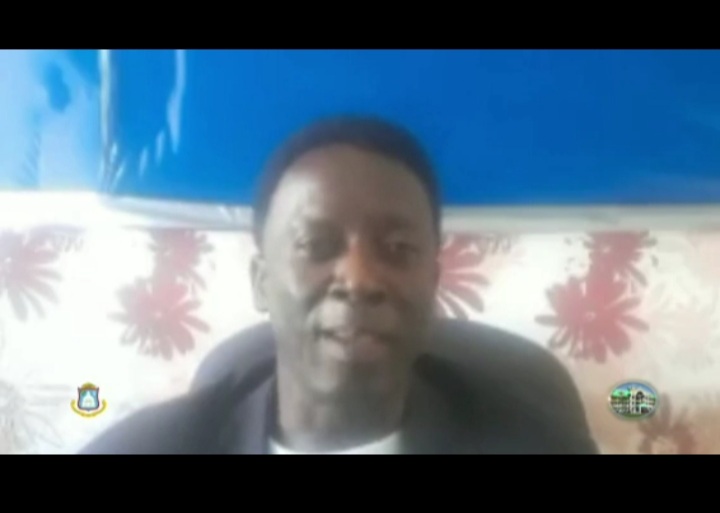UPDATE: Breaking Photos Accident French Saint Martin Click back for details



UPDATE: Breaking Photos Accident French Saint Martin Click back for details






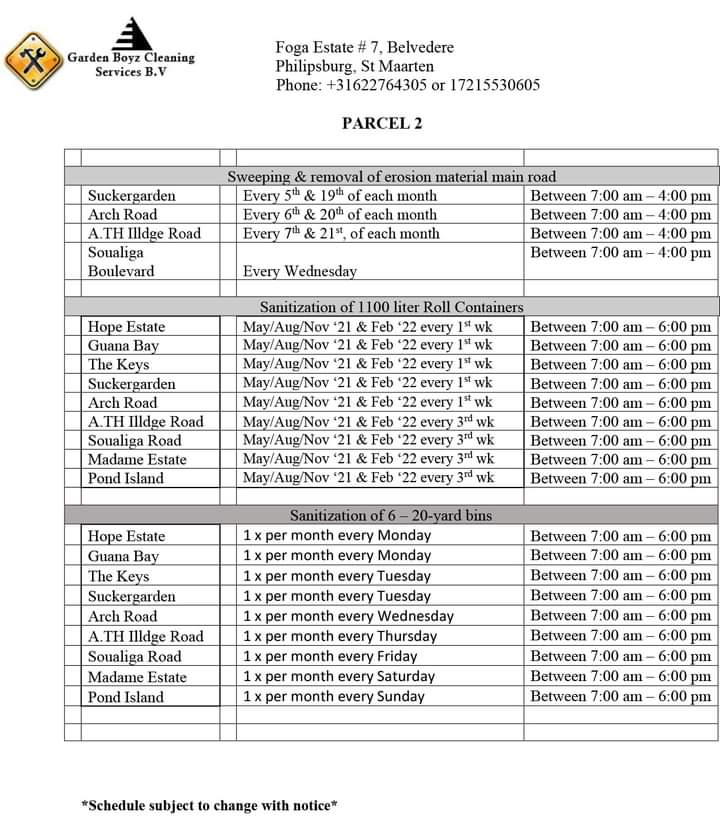

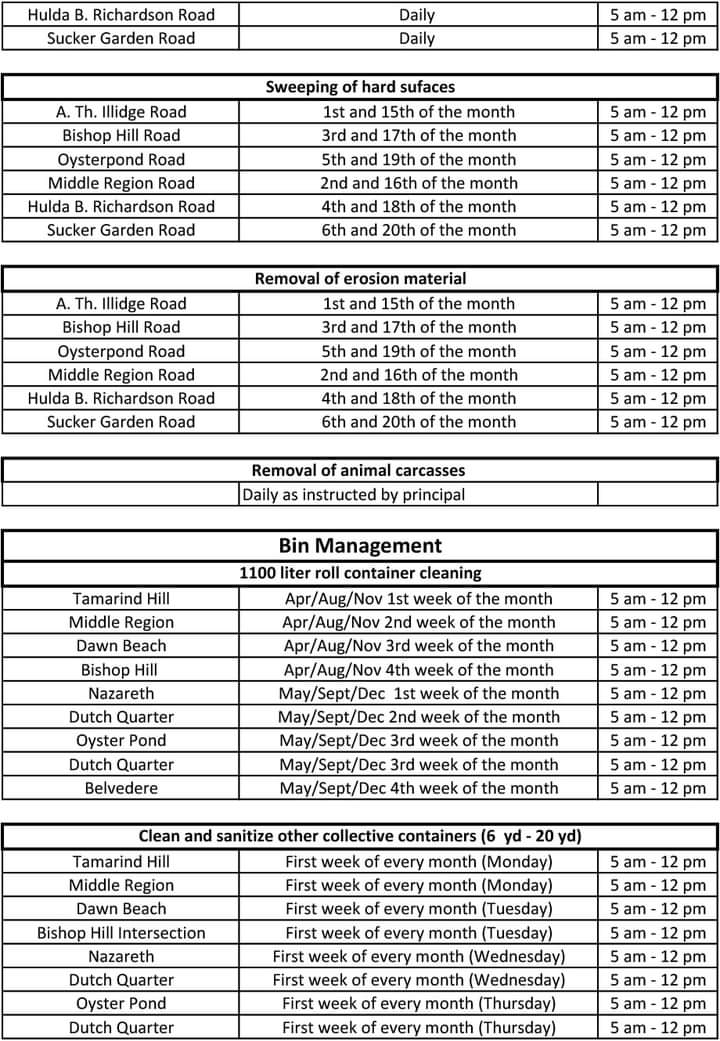




** Waste Collection Schedule 2021 **
French Saint Martín Mask Mandate Being Enforced

General With this perspective on the fight against crime, the Public Prosecutor General of Curaçao, Sint Maarten and Bonaire, Sint Eustatius and Saba presents its vision on law enforcement for the coming years and the way in which it intends to implement this. What are the ambitions? Where is the Public Prosecution Service now and where does it want to go? What role does the Public Prosecution Service itself want to play in the fight against crime and what expectations does it have of the administration, security partners and civil society organizations, citizens, companies and society as a whole?


A




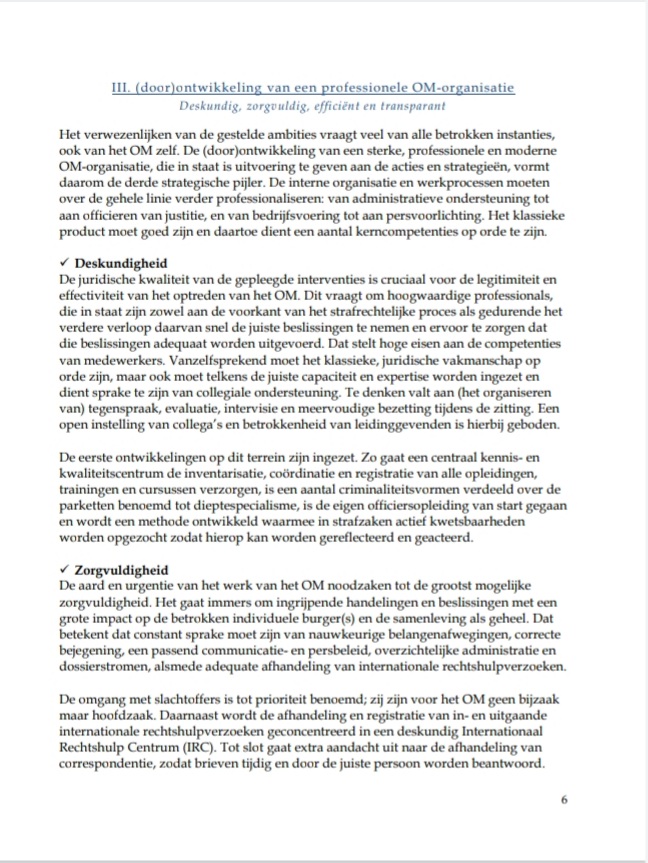




perspective is not an action plan but a course determination. This serves as a guideline for the implementation of policy and actions in the annual plans of the various prosecutors.
Nor does it provide an exhaustive overview of the policy on all the topics covered by it
OM is active. The focus is on important developments and innovations that the Public Prosecution Service – together with the partners and society – wants to realize in the coming years and outlines the broad strategic lines along which these can be implemented.
In recent years, the Public Prosecution Service has been confronted with an increase in investigations into more serious and undermining forms of crime. The threats from (international) organized crime are as great as ever, if not greater than ever. At the same time, in terms of infrastructure and institutions, the countries are currently insufficiently able to cope with this crime, which seeks out the vulnerable scale of young democracies and small-scale societies to settle down. This leads to violations of integrity and fault lines in the rule of law. In addition to these cross-country types of crime, high-impact crime and common crime are also undiminished sources of great concern, because they have a direct influence on the sense of security and insecurity among citizens and entrepreneurs.
Where crime has developed further, law enforcement has not been able to organize itself sufficiently in recent years to provide an adequate response. The Caribbean part of the Kingdom is still too much a hotbed of serious crime, with all the negative consequences that entails. We can no longer afford that situation. The population and society must be able to trust that both crime with a major direct influence on the sense of security, and less visible but at least as damaging undermining crime, are adequately combated. This requires effective interventions that are visible, noticeable and recognizable for victims, perpetrators and society as a whole.
Criminal law contributes to this by correcting and disapproving criminal behavior and repairing the damage suffered. However, this instrument is repressive in nature: by definition
“Retrospectively” and therefore only partially effective in preventing crime. Expectations with regard to criminal intervention alone should therefore not be too high. Criminal law cannot solve all security problems. That is why, in addition to dealing with criminal cases, consultation and collaboration are sought with partners in order to arrive at joint intervention and prevention strategies. The OM sees an initiating role for itself in this.
The need and urgency to invest in a qualitative and organizational further development of law enforcement is great and widely felt. It is in the interest of all countries individually, but also of the Kingdom as a whole, to position a broad, well-organized, efficient and professional law enforcement chain in the various countries, capable and motivated to tackle all forms of crime. The Public Prosecution considers it its task and responsibility to take the initiative in this regard. In doing so, it counts on cooperation with partners, the board and society itself.
1. Ambitions and strategies
The OM’s ambition is to make an effective contribution to a safe and just society and to offer solid guarantees for an ethical democratic constitutional state. Despite all the efforts made in recent years, they have not yet led to the desired results. That is the uncomfortable reality that must be faced. The OM is committed to a definitive turnaround and the concrete question is how. The OM’s strategy is built on three pillars:
I. (further) development of an integrated approach,
II. improving the connection and communication with society, and III. (further) development of a professional Public Prosecution Service organization.
The actions that can contribute in concrete terms to the implementation of this strategy are described in the annual plans of the various prosecutors. This leaves room for the necessary customization per country, an annual assessment of the state of affairs can take place and there is scope for reassessment.
calibrations. The three strategic pillars are outlined below.
I. (further) development of an integrated approach
Wanting and acting together
The current size and organization of the investigation services is insufficient to cope with crime. This ensures that criminals are insufficiently deterred and can often go about their business unhindered because they do not feel the hot breath of the justice system in their necks. However, it is inevitable that the resources available for investigation and prosecution are scarce. The economic reality in the countries will not change this significantly in the coming years. The starting point must therefore be that more is done with the same (human and financial) resources. This means that a strategy must be developed that increases the effectiveness of the enforcement approach structurally and across the board, in terms of both repression and prevention.
Criminal law interventions have a greater social effect if they are not isolated, but are part of a broad, joint strategy of the security network. This so-called integrated approach means that organizations with different disciplines set common goals and ambitions and work together to achieve them. In concrete terms, this means making use of each other’s expertise, capacity and / or powers and sharing information. Depending on the problem, the network that is able to take action is organized and the most effective and promising intervention and prevention strategies are jointly determined. An integrated approach is thus a combination of capacity, quality, diversity, selectivity and the involvement of strategies other than criminal investigation and prosecution.
The security network includes not only criminal law partners, but also the (public) administration, the various enforcement services and all possible relevant (semi-) public and private parties in society. It is precisely this public-private partnership and the participation of unconventional partners that make the integrated approach powerful. This requires commitment from all partners involved and a strong connection with society. The necessary improvement of that connection with society therefore forms the second strategic pillar.
The added value of the integrated approach lies in its hybrid nature, which creates many more possibilities to have an appropriate response to criminal behavior followed, or to prevent such behavior. Examples include taking away criminal assets, administrative enforcement and the creation of administrative barriers, the deployment of multidisciplinary teams, alternative settlement modalities and limiting the influx of offenders through prevention, rehabilitation, aftercare and the involvement of social partners. Based on the conviction that law enforcement will not make it with criminal law intervention alone, more attention will be paid to these alternative network interventions in the coming years and new suitable partners will continue to be sought.
The key to a successful integrated approach is optimal deployment and utilization of the partners’ capacity, expertise, powers and information. This assumes good cooperation and reciprocal relationships. The integrated approach requires commitment to the goals and ambitions, commitment, energy, openness and flexibility of all partners involved. Bureaucracy, domain behavior and double agendas are counterproductive. Essential is a sense of shared responsibility, mutual trust, urgency and “we” thinking. The Public Prosecution Service is explicitly open to the interests of partners and wants to be influenced by their priorities and strategies.
The network approach requires consistent monitoring and accountability for each other’s tasks and responsibilities. Achieved results must be marked and those credits apply to all participating partners. The precise role and position of the partners in the integrated approach must be further elaborated. Recognition of position, interests and powers is essential in this respect. This mutually leads to a sense of reality and understanding and can prevent disappointment and frustration. At the moment, the Public Prosecution Service is still leading in the development of an integrated approach, the search for suitable partners and the setting of common goals. The Public Prosecution Service will endeavor to ensure that the partners take this pioneering role together with the Public Prosecution Service.
II. improving the connection and communication with society Informing and mobilizing
A sustainable transition to a safer, fairer society with less crime and more integrity cannot be achieved without involving that society itself much more emphatically. The vicious circle of clientelism and own bubbleang must be broken by increased confidence in law and justice. Almost all anti-corruption experts insist on the strategic role of the press and civil society in this cultural shift. The decisive factor is that a collective consciousness and public opinion are created that lead to the activist involvement of citizens, companies, social organizations and the media. In this way, society can become an essential partner in the transition to a culture of legality and justice, in which disinterest, resignation and cynicism among the population (‘looking away’, finding crime ‘normal’ and ‘having no faith’). in enforcement services), in which criminal behavior is collectively disapproved of and where there is a sense of norm and shared values.
This is an alternative way, in addition to criminal action, by which crime can be reduced and the undermining “big fish” in their still broad social base can be hit. Law enforcement cannot do it alone. If society itself does not take its responsibility and does not resist lawlessness and corruption, criminal intervention has only a temporary effect and over time other players appear on the scene. It is precisely the cooperating “pincer movement”, of criminal enforcement on the one hand and increasing pressure from below society on the other, that offers the best guarantee for sustainable results.
This change is impossible without broad support for the Public Prosecution Service and the various enforcement services, and the way in which they act. That support consists, among other things, of trust in integrity and expertise and understanding of the choices made and priorities set. Society with its various population groups, organizations, institutions and companies is a “stakeholder” of the rule of law and therefore also of the Public Prosecution Service, which must protect the rule of law. Society has a clear interest in properly functioning services and will therefore in principle want to support them. However, support cannot be taken for granted.
The OM recognizes that its support base has eroded and is currently insufficiently present. The priority is that this is restored and enlarged. This leads to a better relationship with society and more active support and input from the various parties in that society. This phenomenon can develop into an important counterforce where criminogenic factors, persons and behavior manifest themselves. Civil society thus demands its place and takes its responsibility. These positive forces aimed at legality and justice are more than welcome and must be cherished and utilized: society itself must be part of a so-called coalition of the willing.
In order to activate the opposing forces, the Public Prosecution Service will have to continuously inform and mobilize society. It is important to look for (also unexpected) key figures with authority and moral leadership in the field of norms and values, integrity, upbringing and education. This includes churches, schools, community centers and other grassroots grassroots grassroots grassroots organizations such as voluntary organizations, industry associations, sports clubs and community committees. In view of the frequent shocks that pass through society as a result of gross violent crimes or exposed violations of integrity, there are plenty of opportunities to take concrete steps and to address these persons or institutions. By involving them as a party in the security issues and making them part of the network approach, a considerably greater social impact is achieved.
This involvement of society should be based on the idea that the Public Prosecution Service also has a lot to mean for the community: not only satisfaction, support, protection and understanding, but also more practical and concrete matters such as focused attention on neighborhood issues, organizing walk-in consultations, providing information at schools, community offices or community centers, offering the possibility to report crimes anonymously, etc. This requires a new role and attitude of the Public Prosecution Service and its employees, which will be discussed in more detail in Chapter 2.
The Public Prosecution Service invests heavily in the proactive and comprehensible explanation of its actions and decisions and the attractive dissemination of the message it wants to convey, both inside and outside the courtroom. Good communication is the necessary vehicle with which society can be reached and addressed, and with which support can be increased. This can be done on the basis of concrete (iconic) matters or theme sessions, but can also be done without a direct reason. Examples include providing background information about the work and organization of the Public Prosecution Service via social media, organizing workshops and open days.n, and providing information at schools, in community centers in the neighborhoods or elsewhere in society.
III. (further) development of a professional Public Prosecution Service organization
Expert, careful, efficient and transparent
Realizing the stated ambitions demands a lot from all the authorities involved, including the Public Prosecution Service itself. The (further) development of a strong, professional and modern Public Prosecution Service organization, which is able to implement the actions and strategies, therefore forms the third strategic pillar. The internal organization and work processes must be further professionalised across the board: from administrative support to public prosecutors, and from business operations to press information. The classic product must be good and a number of core competencies must be in order for this.
9 Expertise
The legal quality of the interventions carried out is crucial for the legitimacy and effectiveness of the actions of the Public Prosecution Service. This requires high-quality professionals who are able to take the right decisions quickly both at the front of the criminal process and during its further course and to ensure that those decisions are adequately implemented. This places high demands on the competences of employees. It goes without saying that the traditional legal expertise must be in order, but the right capacity and expertise must always be deployed and there must be peer support. This could include (organizing) contradiction, evaluation, peer review and multiple staffing during the session. An open attitude of colleagues and the involvement of managers is required.
The first developments in this field have started. For example, a central knowledge and quality center will take care of the inventory, coordination and registration of all education, training and courses, a number of forms of crime divided among the public prosecutors have been designated in-depth specialism, the company’s own officer training has been started and a method is being developed with which in criminal cases vulnerabilities are actively looked for so that they can be reflected and acted upon.
9 Carefulness
The nature and urgency of the work of the Public Prosecution Service require the greatest possible care. After all, it concerns drastic actions and decisions with a major impact on the individual citizen (s) involved and society as a whole. This means that there must be constant careful weighing of interests, correct treatment, an appropriate communication and press policy, clear administration and file flows, as well as adequate handling of international legal assistance requests.
Dealing with victims has been made a priority; they are not a side issue for the Public Prosecution Service, but the main thing. In addition, the handling and registration of incoming and outgoing international legal assistance requests is concentrated in an expert International Legal Assistance Center (IRC). Finally, extra attention is paid to the handling of correspondence, so that letters are answered on time and by the right person.
9 Efficiency
Suspects and victims must be able to count on expeditious handling of cases, so that everyone knows where they stand as quickly as possible. In addition, execution tasks must be carried out adequately: credible law enforcement stands or falls with effective, prompt and full enforcement of imposed sentences and measures. Furthermore, alternative settlement options must be developed that are simpler, faster and cheaper, such as public prosecution settlements, the ASAP approach, (super) speedy law, mediation, recovery mediation, Hura, Jasap, etc.
An optimally functioning internal Public Prosecution Service is a precondition for achieving efficiency increases. Business operations play a crucial, facilitating role in this. This means that it serves the perfect execution of the primary process. It must ensure the organization and acceleration of (logistics) work processes, a good personnel policy, the availability of up-to-date and accurate management and control information, modern ICT, etc. For a broader effect, the emphasis is placed on cooperation with the operational management of partners.
9 Transparency
The Public Prosecution Service must explain what it does and why it does it, so it must be open and clear about the method it uses, the considerations it makes and the decisions that are made. More transparency leads to more understanding and support. This places considerable demands on communication and also requires uniformity between the public prosecutors, so that the Public Prosecution Service is predictable in its actions. Society must know and understand what the Public Prosecution Service stands for and how it implements it.
An important part of promoting transparency is the adoption and publication of directions and guidelines that affect the field of workconcern the Public Prosecution Service and its partners. In addition, the development of a proactive and accessible press and communication policy is a top priority. Spokesperson, information and maintaining and expanding networks is considered a separate profession and a full-time position.
2. Role and task of OM
The Public Prosecution Service is more externally oriented than before. It has traditionally been legally charged with the criminal enforcement of the legal order and is the only body authorized to bring suspects to a criminal court. However, the ambitions extend further into the current era, in which mopping with the tap is open because crime has become deeply embedded in society and there is an intertwining of the underworld and the upper world. Given its crucial position, the Public Prosecution wants to develop broad initiatives from within the security network and deploy a counterattack. With the help of innovative strategies, the Public Prosecution Service wants to deal crime with a sustainable blow in the coming years, together with partners, administration and society. This requires a different role and method, a strong information position and a focus on a number of specific tasks.
New role
The Public Prosecution Service will have to reinvent itself in order to go a step further than the classic “vertical” role of a magistrate that directs investigations and decides on the prosecution, in which it is case-oriented. A new “horizontal” role needs to be developed, aimed at achieving broad, lasting impacts. In this new role, the Public Prosecution Service is more oriented towards the environment and is at the heart of society. The Public Prosecution Service wants to be an accessible security partner who, as an equal party, seeks consultation and cooperation with relevant parties in order to arrive at joint intervention and prevention strategies. This concerns aspects such as legitimacy, support, visibility, openness, contact, accessibility, information exchange, partnership, connectedness and external focus. There is a direct relationship between these cases and the overall effectiveness of the performance of the Public Prosecution Service. The presence or absence of these elements is decisively determined by the culture of the Public Prosecution Service and the behavior and attitude of its employees.
The playing field is known and familiar in the performance of the classic, vertical role. The new, horizontal role has yet to be mastered and is a (development) process based on “learning by doing” and trial and error, in which it is discovered by trial and error how to achieve profit. One of the challenges for the Public Prosecution Service is to always connect and balance these two roles (case and environment oriented) in such a way that they mutually reinforce each other, resulting in a broader repertoire of actions and greater effectiveness. Important competences of Public Prosecution Service employees are social involvement and sensitivity, willingness to cooperate, curiosity, guts, perseverance and result-orientation.
Information position
A good information position is essential for the social quality that the Public Prosecution Service wants to deliver. This requires a firm anchoring of the Public Prosecution Service and its partners in society. The social context must be known and understood; know what’s going on and why. The Public Prosecution Service and the partners must have the right information and be able to analyze it and process it into intervention and prevention strategies. Based on this knowledge, the right capacity and expertise can then be deployed and managed. In an integrated approach, not only does each partner have their information position in order, but information is also explicitly shared and discussed with each other.
It is essential that the Public Prosecution Service and the partners inform each other in the broadest sense of the factors and actors that affect the safety and integrity of society. This concerns, for example, information about the nature and operation of criminal organizations (infrastructure, players, etc.) and the social effects thereof, about the results of phenomenon studies and projects with which branches, modus operandi and new crime developments can be fathomed and identified at an early stage. identified, and about signals from society about concrete criminogenic factors, key persons and environments. All this information is already available, but scattered across various parties and at different levels. There is enormous gains to be made here. Strengthening information positions, maintaining them systematically and sharing them in a structured manner is a “must” for both the Public Prosecution Service and the partners.
Focus
The actions of the Public Prosecution Service must always be visible and recognizable in society. This means that the priorities and emphases of the Public Prosecution Service in its classic role must constantly be related to social reality. This requires selectivity: kiFor the things that matter most and for the interventions with the greatest social impact. Given the current crime scene in the countries, the Public Prosecution Service will focus in the coming years in both its case-oriented role and its new, environment-oriented role on tackling three types of crime:
cross-border subversive crime, High Impact Crime, and common crime. In addition, the Public Prosecution Service wants to make serious efforts to seize criminal assets.
Undermining cross-border crime poses a major threat to the still young, small-scale and therefore vulnerable democratic constitutional states. The interdependence between the underworld and the upper world is particularly worrying and has a significant social impact. The tough fight against this complex form of crime is top priority. Results achieved prove that the undermineers are caught, their power and prestige can be broken and crime does not pay. The Public Prosecutor’s Office has an initiating role in the programmatic, integrated approach, which is organized above national and national level and which is innovative, alternative and multidisciplinary in character. Additional resources are available for added capacity and specialist expertise.
High Impact Crimes have a major influence on the sense of security among citizens. Society counts on protection and longs for decisive action by the services; for satisfaction, retribution, harmlessness and deterrence. This requires rapid and effective detection, increasing the chances of being caught, expeditious handling of cases, demanding lengthy custodial sentences and a proactive communication strategy. At the same time, investments are being made “up front” in an integrated prevention approach and the prevention of recidivism, especially among youth and young adults, such as by means of the Top C approach. The strategy is aimed at early intervention and the prevention of escalation.
Common crime causes nuisance to society, especially at the neighborhood level. Although not one of the most serious crime phenomena, it is precisely because of the frequent public confrontation in the immediate living environment that this is indeed a source of much unrest and unease among citizens and entrepreneurs. It affects the quality of life and therefore tackling it has priority. Spearheads are prevention and a close-up policy. The services are visibly present, know what is going on in the neighborhoods and who the key figures are (through community and hot spot policing, for example). Interventions provide tangible confirmation of the norm (“up to here and no further”). Rapid execution of these interventions is necessary for a visible correction of criminal behavior.
Finally, the seizure of criminal assets will be a spearhead in the coming years. In view of the fact that almost all crime revolves around monetary gain, and the belief that crime should not pay, criminals are hit in their most vulnerable place, their wallets. By taking illegally acquired assets, the financial advantage is not only taken away in an alternative way and in favor of the countries relatively quickly and easily. Above all, an important signal is sent to perpetrators, victims and society as a whole. A status or exemplary role built up with criminal money is publicly broken down and collective feelings of injustice, insecurity and insecurity are diminished.
There is visible action and society sees that no one is untouchable. Taking away is not a side task, but a core task of the Public Prosecution Service, which must be performed in an integrated approach with many different partners.
Epilogue
The aim of this perspective is to inform the own Public Prosecution Service organization, the various partners, the board and society about the way in which the Public Prosecution Service, together with them, intends to implement crime prevention in the coming years. The emphasis was placed on the developments and innovations that, as far as the Public Prosecution Service is concerned, must take place across the board in order to achieve a safer, more just society with less crime and more integrity. The OM hopes that this new course will capture the imagination of its employees and evoke enthusiasm, creativity, job satisfaction and a new élan.
This document should not become a toothless tiger, it aims to inspire the joint effect of a turning point towards a culture of legality and justice in the countries. The practical implementation requires customization per country and intensive consultation and collaboration with partners, management and private parties in society. The OM is happy to take the lead in this. It will stimulate, promote and facilitate where possible, but also appeals to all parties. After all, achieving a cultural change is a complex processmission-wide task and a shared responsibility.
* * *

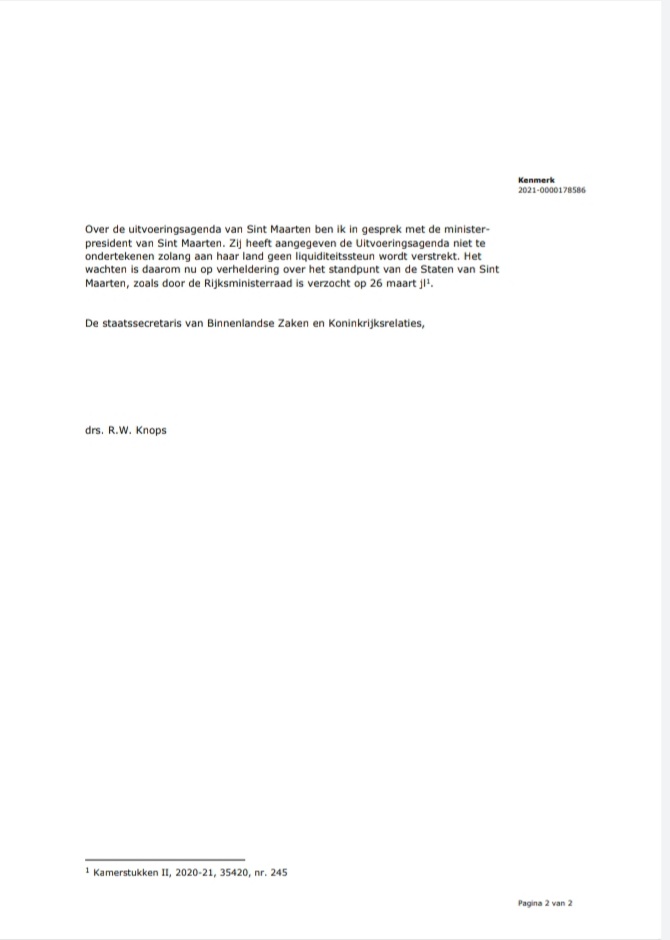
Letter to Parliament on implementation agendas Aruba, Curaçao and Sint Maarten, 2nd quarter 2021: State Secretary Knops will inform the House of Representatives about the implementation agendas with Aruba, Curaçao and Sint Maarten for the 2nd quarter of 2021. The Senate has received the same letter.
TRANSLATION:
In my letter of 26 March to your House in which I inform you about the
decision-making in the Reich Council of Ministers that day, I promised to inform you
about the implementation agendas with Aruba, Curaçao and Sint Maarten. With this letter
I keep that promise.
On Monday, March 29, I held the
implementation agenda for the second quarter of 2021 adopted and
signed. You will find this implementation agenda here. Although the cabinet of
Aruba fell on March 30, this has no consequences for this
implementation agenda made agreements. Prime Minister Wever-Croes has
indicated that current agreements with the Netherlands will continue as usual.
The implementation agendas of Curaçao and Sint Maarten have not yet been signed.
After the elections of March 19, new political relations are in Curaçao
originate. The incoming coalition of MFK and PNP has the government of Curaçao
asked not to take irreversible steps around the agreements with
The Netherlands. It has also been stated that it will take some time to complete all relevant
to study pieces. In view of this wish, the government of Curaçao is of
believe that it is unwise to sign the implementation agenda now. The
The Dutch government hopes that this will soon be possible, so that the
cooperation can be further shaped in the interest of the residents of
Curacao.
Page 2 of 2
I am discussing the implementation agenda of Sint Maarten with the ministerial
president of Sint Maarten. She has indicated that she will not follow the Implementation Agenda
signed as long as no liquidity support is provided to its country. It
We therefore now have to wait for clarification of the position of the States of Sint
Maarten, as requested by the Council of Ministers of the Kingdom on March 26, 2001.
The State Secretary for the Interior and Kingdom Relations,
drs. R.W. Knops
1 Parliamentary Papers II, 2020-21, 35420,
no. 245
https://www.facebook.com/OfficialStMaartenNews/
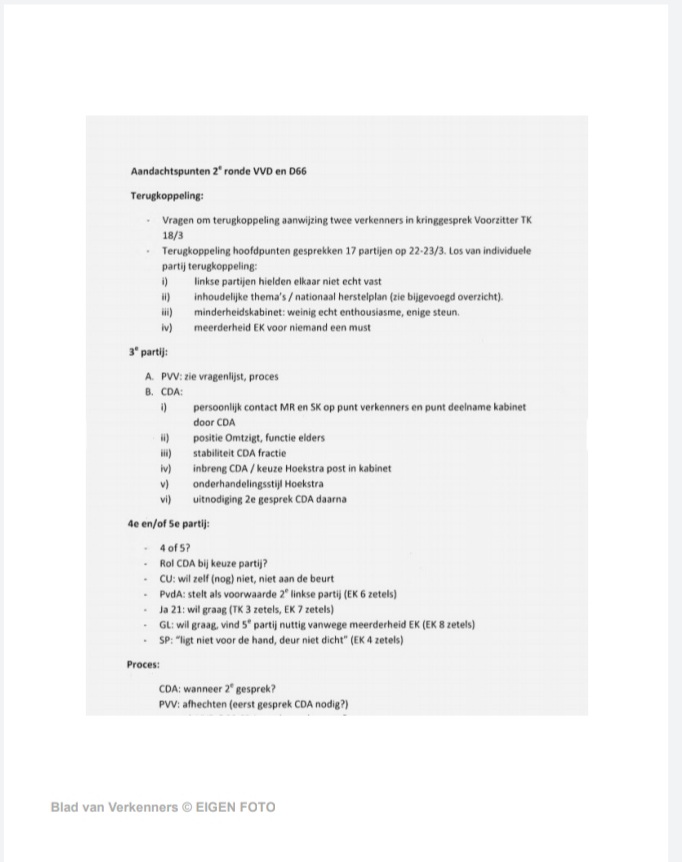
The released documents also show that a cabinet with the PVV was quickly no longer an option. “PVV: tie off”, it says. Which is a term in The Hague for rounding off. However, the scouts still wanted to hear from Rutte and Kaag whether they really wanted to exclude the PVV or whether there was still an option. A whole list of questions had been prepared for this, such as: “Why do you actually exclude PVV?” And “Can the position on exclusion change?”

Considerable part of the House of Representatives extremely fiercely and is considering giving up confidence in Prime Minister |
Explorers Kajsa Ollongren and Annemarie Jorritsma have given openness to their talks before the reconnaissance for a new cabinet failed.
The revelation is explosive because Rutte said earlier that he “in any case had not mentioned Pieter Omtzigt”. Various opposition parties argue that the VVD leader has a confidence problem. “Rutte lied, that’s not nothing,” said SP leader Lilian Marijnissen. “This is why people hate politics.” Think party leader Farid Azarkan announces a motion of no confidence in the debate: “Rutte just lied. If Rutte is honest, he will leave. ” PVV leader Geert Wilders also wants that: ,, Rutte was the one and he lied about it. Get out.” Coalition leaders Wopke Hoekstra (CDA) and Sigrid Kaag (D66) are also fierce: “You cannot remove shamed trust with one comment. Is it possible to repair the heavy damage? ” With this, D66 seems to keep the option open to support a motion of no confidence later.
But CDA leader Wopke Hoekstra leaned back and held the cards to his chest, according to the memos. Hoekstra puts the ball at VVD and D66 and emphasizes time and again that coalition participation cannot be taken for granted: ,, I do not think it is obvious to participate. At one point our potential was just as great as VVD, what’s left of it: 15 meager seats. I was also not approached by Mark or Sigrid, my assessment is that there have been other contacts. I’m not going to be tempted by all kinds of variants. I have hesitations as to how your process began. It’s up to VVD-D66 to start pim-pam hats now. ”
D66 leader Sigrid Kaag wants to form “from the content”, but did comment in the Stadhouderskamer on preferential coalitions. The notes of ex-scout Ollongren show that Kaag wants a coalition with five parties, with besides VVD and the CDA also PvdA and GroenLinks – “as progressive as possible”. CU is not a first option, Kaag outlined, mainly due to the medical-ethical issues: “We are not going to delay for another four years.”

The formation of a new government has degenerated into total chaos due to the blunder with a secret memo last week: Kajsa Ollongren (D66) and Annemarie Jorritsma (VVD) stepped up as scouts, yesterday they already shared some secret reports with parliament, this morning at the request of the House of Representatives, a further dozen pages were published, partly handwritten, by scouts and officials.
These notes show that Rutte was upset with a reluctant CDA. In Rutte’s conversation with the scouts, the prime minister states that he hopes the party will “recover”: “You probably need them. It gets very complicated without the CDA. More time may be needed. If Wopke has more votes than Omtzigt, that will help. ” Then follows the sentence: “You have to make something with Omtzigt: minister.”
Incidentally, this is stated in the typed text of the conversation with Rutte. It is slightly different in the handwritten original. It says “CDA: you have to do something with Omtzigt: minister”.
According to Rutte, he would “not attract” a cabinet with PvdA and GroenLinks. Why that left cloud? You don’t need them both for a majority next to the CDA.
Former scouts Ollongren and Jorritsma also have something to explain: “position elsewhere” would “in no way have been discussed with the party leaders,” they wrote to the House of Representatives through the successors.
The formation of a new government has degenerated into total chaos due to the blunder with a secret memo last week: Kajsa Ollongren (D66) and Annemarie Jorritsma (VVD) stepped up as scouts, yesterday they already shared some secret reports with parliament, this morning At the request of the House of Representatives, dozens more pages were published, partly handwritten, by scouts and civil servants.
These notes show that Rutte was upset with a reluctant CDA. In Rutte’s conversation with the scouts, the prime minister states that he hopes the party will “recover”: “You probably need them. It gets very complicated without the CDA. More time may be needed. If Wopke has more votes than Omtzigt, that will help. ” Then follows the sentence: “You have to make something with Omtzigt: minister.”
Incidentally, this is stated in the typed text of the conversation with Rutte. In the handwritten original it is slightly different. It says “CDA: you have to do something with Omtzigt: minister”.
According to Rutte, he would “not attract” a cabinet with PvdA and GroenLinks. Why that left cloud? You don’t need them both for a majority next to the CDA. ”
But CDA leader Wopke Hoekstra leaned back and held the cards to his chest, according to the memos. Hoekstra puts the ball at VVD and D66 and emphasizes time and again that coalition participation cannot be taken for granted: ,, I do not think it is obvious to participate. At one point, our potential was just as great as VVD, what’s left of it: 15 meager seats. I was also not approached by Mark or Sigrid, my assessment is that there have been other contacts. I am not going to be tempted by all kinds of variants. I have hesitations as to how your process began. It’s up to VVD-D66 to start pim-pam hats now. ”
Other parties and the scouts are struggling with the CDA: how can the Christian Democrats still get on board? And do they have everything in order internally? Explorer Annemarie Jorritsma notes: “the most realistic is the opposition”. Anyone who reads other pre-formation documents about the CDA also thinks: what was Wopke Hoekstra actually doing in that Stadhouderskamer? In all major themes – migration, climate, economy – the CDA box remained remarkably empty, while other parties did anticipate their wishes and plans.
VVD leader Rutte still states that he would prefer to continue with the ChristenUnie, but if it comes to the left-wing parties, then “sooner” with the SP than the Pvda-GroenLinks combination, “unless they are willing to let go of each other”. “If they don’t hold on to each other, then a slight preference for PvdA, because concern about GL together with D66: a lot of climate”. He also said: ,, PvdA also exciting: if they really want to then fine, but if they go with long teeth, then less enthusiastic. 42 mid (billion, ed.) Increasing the burden on the business community is far too much. ”


Incidentally, the PvdA interview report shows that PvdA did not intend to enter the cabinet without GroenLinks or SP. Lilianne Ploumen noted: “A VVD-D66-PvdA coalition cannot be without another left-wing party (D66 is not a left-wing party).” SOURCES GOOGLE & AD.NL
According to minister Knops, Sint Maarten Prime Minister, Silveria Jacobs won’t sign the implementation agenda until she is assured liquidity. Minister of Finance, Ardwell Irion in yesterday March 31st 2021 Council of Ministers Press Briefing, made it seem like the next tranche of liquidity support is a done deal.
However, it is obvious by the letter sent by Minister Knops, minutes ago, that there is no guarantee.
Letter to Parliament on implementation agendas Aruba, Curaçao and Sint Maarten, 2nd quarter 2021: State Secretary Knops will inform the House of Representatives about the implementation agendas with Aruba, Curaçao and Sint Maarten for the 2nd quarter of 2021.
The implementation agendas of Curaçao and Sint Maarten have not yet been signed. After the elections of March 19, new political relations in Curaçao are forming . The incoming coalition of MFK and PNP has the government of Curaçao asked not to take irreversible steps around the agreements with The Netherlands. It has also been stated that it will take some time to complete all relevant
to study pieces. In view of this wish, the government of Curaçao is of
believe that it is unwise to sign the implementation agenda now. The
The Dutch government hopes that this will soon be possible, so that the
cooperation can be further shaped in the interest of the residents of
Curacao.
Page 2 of 2
I am discussing the implementation agenda of Sint Maarten with the ministerial president of Sint Maarten. She has indicated that she will not follow the Implementation Agenda
signed as long as no liquidity support is provided to its country. It
We therefore now have to wait for clarification of the position of the States of Sint Maarten, as requested by the Council of Ministers of the Kingdom on March 26, 2001.
The State Secretary for the Interior and Kingdom Relations,
drs. R.W. Knops
1 Parliamentary Papers II, 2020-21, 35420,
no. 245 MORE INFO: SXMGOVERNMENT.COM



Video 1 Todays Dutch Sint Maarten Government Press Briefing
Deputy Prime Minister Egberto Doran York Visited SHDF Belvedere yesterday. More fixed roofs and home repair at duplexes, which were the main concerns. The Towers are underconstruction renovated by end of year with funds. More progress. Working with the banks.
The Prime Minister had met with Kingdom about consensus law, country package etc. Yesterday Silveria Jacob’s informal meeting Knops with Sillie And Rolando friendly Ongoing discussion. Once Doran York is updated will let you know.


Video 5 Lyndon Brown Believes Minister Panneflek appearance is different since getting the COVID-19 Vaccine.
He Questions Minister Panneflek about differences between PCR and Rapid Antigen Tests
PCR takes longer and Antigen 15-20 minutes. One is a swab, one has to use a lab. Only when both give same results then results are allowed. Technology is improving https://www.facebook.com/OfficialStMaartenNews/
